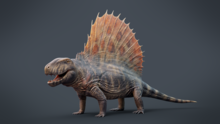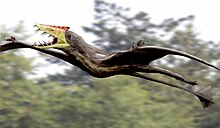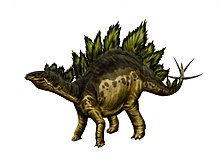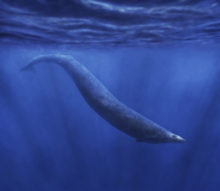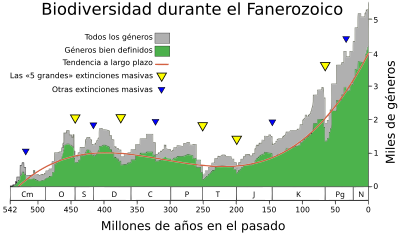Phanerozoic eon
| Super | Eon | Millions of years |
|---|---|---|
| Fanerozoic | 538.8 ±0.2 | |
| Precámbrico | Proterozoic | 2500 |
| Arcaico | 3.800 | |
| Hádico | ca. 4.570 |
The Phanerozoic eon is a division of the geologic time scale that extends from 542.0 ±1.0 million years ago to the present day. It succeeds the Precambrian, which spans the time remaining since the formation of the Earth. Its name derives from the Greek (φανερός phanerós "visible", ζῷον zôon "living being") and means "visible life", referring to the size of the organisms that arise in this epoch. Long before this eon, life already existed on Earth, however it is during this period that living organisms already take complex forms, evolve and diversify widely.
Geologically, the Phanerozoic begins shortly after the breakup of the supercontinent Pannotia; over time, the continents regroup into another supercontinent, Pangea; and finally, it breaks up, giving rise to the current continents.
Proterozoic-Phanerozoic Boundary
The Proterozoic-Phanerozoic boundary is at 538 million years. In the 19th century, the boundary was established at the time of the appearance of the first abundant animal fossils (metazoans), but several hundred groups (taxa) of metazoans from the earlier Proterozoic eon have been identified since systematic study of those forms began. in the 1950s.
Subdivisions
The Phanerozoic is divided into three eras: Paleozoic, Mesozoic, and Cenozoic, which were formerly called the Primary, Secondary, and Tertiary eras, respectively.
| Eon | It was | Period | Época | Millions of years |
|---|---|---|---|---|
| Fanerozoic | Cenozoico | Quaternary | Holocene | 0.011784 |
| Pleistocene | 2.588 | |||
| Neogen | Plioceno | 5,332 | ||
| Miocene | 23,03 | |||
| Paleogen | Oligoceno | 33.9 ±0.1 | ||
| Eocene | 55.8 ±0.2 | |||
| Paleocene | 66.0 | |||
| Mesozoic | Cretaceous | 145.5 ±4,0 | ||
| Jurassic | 199,6 ±0.6 | |||
| Triassic | 251.0 ±0.4 | |||
| Paleozoic | Permico | 299,0 ±0.8 | ||
| Carboniferous | Pennsylvania | 318,1 ±1,3 | ||
| Mystery | 359,2 ±2,5 | |||
| Devon | 416.0 ±2,8 | |||
| Silurico | 443.7 ±1.5 | |||
| Ordovici | 488,3 ±1,7 | |||
| Warm | 538.8 ±0.2 |
Eras of the Phanerozoic
The Phanerozoic is divided into three eras: Paleozoic, Mesozoic, and Cenozoic, which are further subdivided into 12 periods. The Paleozoic presents the evolution of fish, amphibians and reptiles. The Mesozoic features the evolution of lizards, crocodiles, snakes, turtles, mammals, and dinosaurs (including birds). The Cenozoic begins with the extinction of non-avian dinosaurs and presents an evolution of great diversity in birds and mammals. Humans appeared and evolved during the most recent part of the Cenozoic.
Paleozoic Era
The Paleozoic is a time in Earth's history when complex life forms evolved, took their first breath of oxygen on dry land, and when the precursors of all multicellular life on Earth began to diversify. There are six periods in the Paleozoic era: Ordovician Cambrian, Silurian, Devonian Carboniferous, and Permian.
Cambrian Period
The Cambrian is the first period of the Paleozoic Era and lasted from 538 million to 485 million years ago. The Cambrian caused a rapid expansion in animal diversity, in an event known as the Cambrian Explosion, during which the largest number of animal body plans evolved in a single period in human history. Land. Complex algae evolved and the fauna was dominated by armored arthropods, such as trilobites. Almost all the phyla of marine animals evolved in this period. During this time, the supercontinent Pannotia began to break up, most of which later recombined into the supercontinent Gondwana.
Ordovician Period
The Ordovician spans from 485 million to 444 million years ago. The Ordovician was a time in Earth's history when many groups that are still prevalent today evolved or diversified, such as primitive cephalopods, fish, and corals. This process is known as the Great Ordovician Biodiversification Event or GOBE. Trilobites began to be replaced by jointed brachiopods, and crinoids also became an increasingly important part of the fauna. The first arthropods crawled ashore to colonize Gondwana, a continent devoid of animal life. By the end of the Ordovician, Gondwana had moved from the Equator to the South Pole, and Laurentia had collided with Baltica, closing the Iapetus Ocean. The Gondwana glaciation caused a significant drop in sea level, wiping out all life that had settled along its coast. The glaciation caused an ice house on Earth, leading to the Ordovician-Silurian extinction, during which 60% of marine invertebrates and 25% of families went extinct. Although it was one of the deadliest mass extinctions in Earth's history, the SW extinction did not cause profound ecological changes between periods.
Silurian Period
The Silurian spans from 444 million to 419 million years ago, which saw an ice house warming of the Earth. This period saw the massive evolution of fish, as jawless fish became more numerous and the first jawed, freshwater fish appeared in the fossil record. Arthropods remained abundant, and some groups, such as eurypterids, became apex predators. Fully terrestrial life established itself on land, including the first arachnids, fungi, and myriapods (many-legged arthropods). The evolution of vascular plants such as Cooksonia allowed plants to gain a foothold in the soil as well. These first land plants are the precursors to all plant life on earth. During this time, there were four continents: Gondwana (Africa, South America, Australia, Antarctica, India), Laurentia (North America with parts of Europe), Baltica (the rest of Europe), and Siberia (North Asia).
Devonian Period
The Devonian spans from 419 million to 359 million years ago. Also known informally as the 'Age of Fishes', the Devonian presents a great diversification of fish. Armored fish included "agnathans" jawless, as well as jawed placoderms such as Dunkleosteus. The Devonian also saw a diversification of modern fish groups such as chondrichthyans (sharks and their relatives), osteichthyans (ray-finned fish), and sarcopterygians (lobe-finned fish). A lineage of sarcopterygians evolved into the first four-limbed vertebrates, which would eventually become tetrapods. On land, the plant groups diversified; the first trees and seeds evolved during this period. In the Middle Devonian, there were shrubby forests of early plants: lycophytes, Equisetales, ferns, and progymnosperm. This event also allowed the diversification of the life of the arthropods that took advantage of the new habitat. Near the end of the Devonian, 70% of all species became extinct in a sequence of mass extinction events, collectively known as the Devonian mass extinction.
Carboniferous Period
The Carboniferous spans from 359 million to 299 million years ago. Tropical swamps dominated the Earth, and the vast amounts of trees created much of the carbon that was converted to carbon deposits (hence the name Carboniferous).. Approximately 90% of all coal beds were deposited in the Carboniferous and Permian periods, representing only 2% of Earth's geological history. The high oxygen levels caused by these swamps provided more chemical energy that allowed massive arthropods, normally limited in size by their respiratory systems to proliferate. Tetrapods diversified during the Carboniferous, and one lineage acquired an amniotic egg that could survive out of water. These tetrapods, the amniotes, included the earliest reptiles and synapsids (relatives of mammals). Throughout the Carboniferous, there was a pattern of cooling, which eventually led to the Gondwana glaciation, as much of it was situated around the south pole. This event was known as the Permo-Carboniferous glaciation and resulted in a major loss of area for coal forests, the Carboniferous Rainforest Collapse.
Permian Period
The Permian spans from 298 million to 251 million years ago and was the last period of the Paleozoic era. At first, all the continents joined to form the supercontinent Pangea, surrounded by an ocean called Panthalassa. The Earth was relatively dry compared to the Carboniferous, with harsh seasons, since the climate of the interior of Pangea was not moderated by large bodies of water. Amniotes flourished and diversified in the new dry climate, particularly synapsids like Dimetrodon, Edaphosaurus, and the ancestors of modern mammals. The first conifers evolved during this period, then dominated the terrestrial landscape. The Permian ended with at least one mass extinction, the Permian-Triassic mass extinction, an event sometimes known as "the Great Dying." This extinction was the largest in earth's history and caused the loss of 95% of all species of life.
Mesozoic Era
The Mesozoic spans between 252 million and 66 million years ago. Colloquially known as the 'Age of the Dinosaurs', the Mesozoic features the emergence of many modern tetrapods, as reptiles ascend to ecological dominance over synapsids. There are three periods in the Mesozoic: Triassic, Jurassic, and Cretaceous.
Triassic Period
The Triassic comprises between 252 million and 201 million years ago. The Triassic is a transitional time in Earth's history between the Permian Extinction and the exuberant Jurassic Period. It has three main epochs: Early Triassic, Middle Triassic, and Late Triassic.
The Early Triassic lasted between 252 million and 247 million years ago, and was a hot and arid time after the Permian Extinction. Many tetrapods during this time represented a disaster fauna, a group of animals with low diversity and cosmopolitanism (wide geographic ranges). Temnospondyli recovered and diversified again into large aquatic predators during the Triassic. Reptiles also diversified. rapidly, with aquatic reptiles such as ichthyosaurs and sauropterygians proliferating in the seas. On land, the first true archosaurs appeared including pseudosuchians (relatives of crocodiles) and avemetatarsalians (relatives of birds/dinosaurs).
The Middle Triassic extends from 247 million to 237 million years ago. The Middle Triassic featured the beginnings of Pangea's breakup as rift began in northern Pangea. The northern part of the Tethys Ocean, the Paleotethys Ocean, had become a passive basin, but a spreading center was active in the southern part of the Tethys Ocean, the Neotethys Ocean. Phytoplankton, corals, crustaceans, and many others Invertebrates recovered from the Permian extinction in the late Middle Triassic. Meanwhile, on land, reptiles continued to diversify, coniferous forests flourished, as did the first flies.
The Late Triassic extends from 237 million to 201 million years ago. After the Middle Triassic boom, the Late Triassic was hot and arid, with a strong monsoon climate and most rainfall limited to the coastal regions and high latitudes. The first true dinosaurs appeared in the early Late Triassic, with pterosaurs evolving somewhat later. Other large reptile competitors to the dinosaurs were wiped out by the Triassic-Jurassic extinction event in the that most archosaurs (excluding crocodylomorphs, pterosaurs, and dinosaurs), many synapsids, and nearly all large amphibians went extinct, as well as 34% of marine life in the fourth mass extinction event. The cause of the extinction is debated, but it was probably due to eruptions from the large igneous province CAMP.
Jurassic Period
The Jurassic spans between 201 million and 145 million years ago, and presents three main epochs: Early Jurassic, Middle Jurassic, and Late Jurassic.
The Early Jurassic epoch extends from 201 million to 174 million years ago. The climate was much wetter than during the Triassic, and as a result the world was warm and partly tropical, though possibly with intervals. ichthyosaurs and ammonites dominated the seas, while dinosaurs and other reptiles dominated the land, with species such as Dilophosaurus at the apex. Crocodylomorphs evolved into aquatic forms, leading to large amphibians on the brink of extinction. True mammals were present during the Jurassic, but remained small, with average body masses of less than 10 kilograms until the end of the Cretaceous.
The Middle and Late Jurassic epochs span from 174 million to 145 million years ago. Coniferous savannahs made up a large part of the world's forests. In the oceans, plesiosaurs were fairly common, and ichthyosaurs they were blooming. [50] The Late Jurassic epoch extends from 163 million to 145 million years ago. The Late Jurassic saw a severe extinction of sauropods on the northern continents, along with many ichthyosaurs. However, the Jurassic-Cretaceous boundary did not have a strong impact on most forms of life.
Cretaceous Period
The Cretaceous is the longest period of the Phanerozoic and the last period of the Mesozoic. It extends from 145 million to 66 million years ago, and is divided into two epochs: the Early Cretaceous and the Late Cretaceous.
The Early Cretaceous epoch extends from 145 million to 100 million years ago. Dinosaurs continued to be abundant, with groups such as tyrannosaurids, avians (birds), marginocephalians, and ornithopods seeing early flashes of later success. Other tetrapods, such as stegosaurs and ichthyosaurs, declined significantly, and sauropods were confined to the southern continents.
The Late Cretaceous epoch extends from 100 million to 66 million years ago. The Late Cretaceous featured a cooling trend that would continue into the Cenozoic Era. Eventually, the tropical climate became restricted to the equator, and areas beyond the tropical lines featured more seasonal climates. Dinosaurs still thrived as new species like Tyrannosaurus, Ankylosaurus, Triceratops, and hadrosaurs dominated the food web. It is debated whether or not pterosaurs went into decline as the birds radiated; however, many families survived into the late Cretaceous, alongside new forms such as the gigantic Quetzalcoatlus. Mammals diversified despite their small size, with metatherians (marsupials and relatives) and eutherians (placentals and relatives) becoming yours. In the oceans, mosasaurs branched out to fill the role of the now-extinct ichthyosaurs, along with huge plesiosaurs such as Elasmosaurs. In addition, the first flowering plants evolved. At the end of the Cretaceous, the Deccan Traps and other volcanic eruptions were poisoning the atmosphere. As this continued, a large meteor is believed to have slammed into Earth, creating the Chicxulub crater and the event known as the K–Pg extinction, the fifth and most recent mass extinction event, during which 75% of life died. on Earth it became extinct, including all non-avian dinosaurs. All living things with a body mass of more than 10 kilograms became extinct and the age of the dinosaurs came to an end.
Cenozoic Era
The Cenozoic was marked by the rise of mammals as the dominant class of animals, as the end of the age of the dinosaurs left important niches open. There are three divisions of the Cenozoic: Paleogene, Neogene, and Quaternary.
Paleogene Period
The Paleogene spans from the extinction of non-avian dinosaurs, about 66 million years ago, to the dawn of the Neogene 23 million years ago. It presents three epochs: Paleocene, Eocene and Oligocene.
The Paleocene epoch began with the K–Pg extinction event, and the early part of the Paleocene saw Earth's recovery from that event. The continents began to take their modern forms, but most of the continents (and India) remained separate from each other: Africa and Eurasia were separated by the Tethys Sea, and the Americas were separated by the Strait of Panama, like the Isthmus. of Panama had not yet been formed. This epoch featured a general warming trend, and the first modern jungles expanded, eventually reaching the poles. The oceans were dominated by sharks, as the great reptiles that once ruled had gone extinct. Mammals diversified rapidly, but most remained small. The largest tetrapod carnivores during the Paleocene were reptiles, including crocodylliforms, choristoderans, and snakes. Titanoboa, the largest known snake, lived in South America during the Paleocene.
The Eocene epoch ranged from 56 to 34 million years ago. In the early Eocene, most land mammals were small and lived in tight jungles, just like in the Paleocene. Among them were the earliest primates, whales, and horses, along with many other early forms of mammals. The climate was hot and humid, with little temperature gradient from pole to pole. In the mid-Eocene epoch, the Circum-Antarctic Current formed between Australia and Antarctica, disrupting ocean currents around the world, causing global cooling and shrinking rainforests. The more modern forms of mammals continued to diversify in the cold climate even as the more archaic forms died out. By the end of the Eocene, whales such as Basilosaurusse had become fully aquatic. The late Eocene epoch saw the rebirth of the seasons, causing the expansion of savannah-like areas with the first substantial grasslands. At the transition between the Eocene and Oligocene epochs there was a significant extinction event, the cause of which was is debated.
The Oligocene epoch extends from 34 million to 23 million years ago. The Oligocene was an important transition period between the tropical world of the Eocene and more modern ecosystems. This period featured a global expansion of grass that led to many new species taking advantage, including the first elephants, cats, dogs, marsupials, and many other species that are still prevalent today. Many other plant species also evolved during this time, such as evergreen trees. Long-term cooling continued, and seasonal rainfall patterns were established. Mammals continued to grow. Paraceratherium, one of the largest land mammals to have ever lived, evolved during this time, along with many other perissodactyls.
Neogene Period
The Neogene spans from 23.03 million to 2.58 million years ago. It presents two epochs: the Miocene and the Pliocene.
The Miocene extends from 23.03 million to 5.333 million years ago and is a period in which grass spread further, effectively dominating much of the world, dwindling forests in the process. The kelp forests evolved, leading to the evolution of new species, such as sea otters. During this time perissodactyls thrived and evolved into many different varieties. Alongside them were the apes, which evolved to 30 species. In general, dry, mountainous lands dominated most of the world, as did pastoralists. The Tethys Sea finally closed with the creation of the Arabian Peninsula and in its wake left the Black, Red, Mediterranean and Caspian seas. This only increased the aridity. Many new plants evolved, and 95% of modern seed plants evolved in the mid-Miocene.
The Pliocene lasted from 5.333 million to 2.58 million years ago. The Pliocene featured dramatic climate changes, which eventually led to modern species and plants. The Mediterranean Sea dried up for hundreds of thousands of years in the Messinian Salt Crisis. Along with these important geological events, Africa saw the appearance of Australopithecus, the ancestor of Homo. The Isthmus of Panama was formed and animals migrated between North and South America, wreaking havoc on the local ecology. Climate changes brought savannahs that are still spreading around the world, Indian monsoons, deserts in East Asia, and the beginnings of the Sahara desert. Earth's continents and seas took their present forms. The map of the world has not changed much since then, except for changes caused by Quaternary ice ages, such as the Great Lakes.
Quaternary Period
Pleistocene megafauna (mammoths cave lions woolly rhinos reindeer horses)
The Quaternary extends from 2.58 million years ago to the present, and is the shortest geological period of the Phanerozoic Eon. Features modern animals and dramatic changes in weather. It is divided into two epochs: the Pleistocene and the Holocene.
The Pleistocene lasted from 2.58 million to 11,700 years ago. This epoch was marked by a series of glacial periods (ice ages) as a result of the cooling trend that began in the middle Eocene. There were numerous separate glaciation periods marked by the advance of ice caps to 40 degrees north latitude in montaneous areas. Meanwhile, Africa experienced a drying trend that resulted in the creation of the Sahara, Namib, and Kalahari deserts. Mammoths, giant ground sloths, dire wolves, saber-toothed cats, and humans were common and widespread during the Pleistocene. As the Pleistocene neared its end, a major extinction wiped out much of the world's megafauna including the human species of Homo sapiens such as Homo neanderthalensis. All continents were affected, but Africa was affected to a lesser extent. That continent supported many large animals, such as elephants, rhinos, and hippos. The extent to which Homo sapiens was involved in this extinction is debated.
The Holocene began 11,700 years ago and continues to this day. All recorded history and "human history" it lies within the confines of the Holocene epoch. Human activity is blamed for an ongoing mass extinction that began approximately 10,000 years ago, although species that went extinct have only been recorded since the Industrial Revolution. This is sometimes known as the " Sixth Extinction ". Hundreds of species have become extinct due to human activity since the Industrial Revolution.
Life
The boundary between the Precambrian and the Phanerozoic eon was set at the 19th century at the point where it begins to There is an abundance of fossil metazoans. However, several hundred metazoan taxa have been identified in the Proterozoic since the 1950s. Most geologists and paleontologists currently peg the transition at one of the following points: the point at which the first trilobites appear and Archaeocyanites, at the point where the Ichnofossil Trichophycus pedum appears, or else at the point of the first appearance of the “small shelled fossils”, a group of small animals, generally armored and not articulated. The three points differ by a few million years from each other.
The Phanerozoic saw the rapid appearance and diversification of a series of animal phyla, the appearance of land plants, and the appearance of fish and land animals.
Biodiversity
During the Phanerozoic, biodiversity shows a general, but not monotonous, increase from nearly zero to several thousand genera. Changes in biodiversity through the Phanerozoic have been shown to correlate much better with the hyperbolic model (widely used in demography and macrosociology) than with exponential and logistic models (traditionally used in population biology and widely applied to biodiversity as well). fossil). The latest models imply that changes in diversity are guided by first-order positive feedback (more ancestors, more descendants) or negative feedback arising from resource constraints, or both. The hyperbolic model implies a second order positive feedback. The hyperbolic pattern of human population growth arises from quadratic positive feedback, caused by the interaction of population size and the rate of technological growth. The character of biodiversity growth in the Phanerozoic Eon can be explained in a similar way. by a feedback between the diversity and complexity of the community structure. It has been suggested that the similarity between the biodiversity and human population curves is probably due to the fact that both derive from the overlap in hyperbolic trend of cyclical and random dynamics.
Contenido relacionado
Ural mountains
Mount Everest
Richter seismic scale





